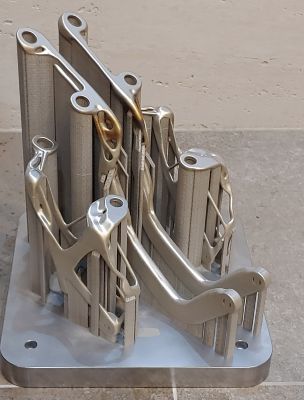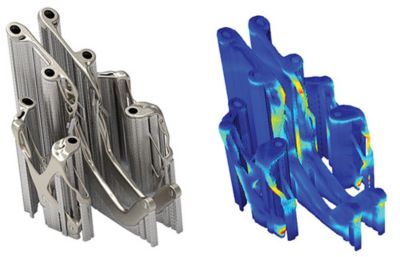-
United States -
United Kingdom -
India -
France -
Deutschland -
Italia -
日本 -
대한민국 -
中国 -
台灣
-
Ansys는 학생들에게 시뮬레이션 엔지니어링 소프트웨어를 무료로 제공함으로써 오늘날의 학생들의 성장을 지속적으로 지원하고 있습니다.
-
Ansys는 학생들에게 시뮬레이션 엔지니어링 소프트웨어를 무료로 제공함으로써 오늘날의 학생들의 성장을 지속적으로 지원하고 있습니다.
-
Ansys는 학생들에게 시뮬레이션 엔지니어링 소프트웨어를 무료로 제공함으로써 오늘날의 학생들의 성장을 지속적으로 지원하고 있습니다.
ANSYS ADVANTAGE MAGAZINE
January 2021
Additive Manufacturing Hinges on Optimization
By Ansys Advantage Staff
Hyundai Motor Group’s analysis team and the design for additive manufacturing (DfAM) lab of TAE SUNG S&E (TSNE) recently developed an automotive hood hinge with Ansys Additive solutions. TSNE is an Ansys Elite Channel Partner in Korea. The optimized hinge weighed 13% less and was 5X stiffer than the previous hinge.
The design won the grand prize at the annual Korea Additive Manufacturing User Group (KAMUG) DfAM Competition, which celebrates 3D printing and manufacturing convergence cases and commercialization. The team used Ansys Additive Prep to design the hood hinge with topology optimization and Ansys Additive Print to predict recoater crash, crack and deformation problems. They built a metal hood hinge after verifying and checking the external shape and internal overhang area via computed tomography (CT) scans.
We caught up with Jun Cheol Lee, manager of the Advanced Manufacturing Computer-Aided Engineering Team at Hyundai Motor Group, to learn more about the topology optimization process for the hood hinge.
Ansys Advantage: What motivated you to participate in this competition?
Jun Cheol Lee: I think it was a very relevant chance to augment our capacity in additive manufacturing. All procedures — making out a plan, learning about additive manufacturing simulation and building real parts using additive machinery — are great experiences for us.
AA: What are the benefits of topology optimization and additive manufacturing?
Lee: Topology optimization basically provides a solution that increases the stiffness while reducing the weight of the product. The important point is that it is very difficult to increase the stiffness when using the existing shape as it is. By making the optimization area as large as possible, it is possible to increase the rigidity in the process of leaving only the really necessary areas and removing other areas. As a result, we can deviate from the traditional shape design. We can make any shape of a part with the right performance. Lightweighting and performance improvements can coexist.
AA: Can you take me through the process of creating the new hood hinge design, step by step? How did you redefine the design domain?
Lee: A traditional hinge bracket has a single support. It is good for mass production, but very weak for Y-axis direction forces. So we choose double support brackets to improve Y-direction deformation.
AA: What are the considerations of going from stereolithography (STL) to computer-aided design (CAD)?
Lee: This is a very important part. Sometimes, we must convert the model for use in CAD tools. Ansys provides a very easy and open conversion solution.
AA: How did you ensure the optimal means to additively manufacture the part (orientation, supports, deformation prediction, build quality/ porosity)?
Lee: In this case, we did not make many choices about orientation. The length of the hinge almost fits the limit of the machine-made height, and there is a certain amount of pressure, so all the parts must be separated by an hour. Therefore, we applied improved supports so that there is less deformation.
Orientation support
Additive manufacturing process simulation
AA: How was Ansys Additive Prep and Print helpful in the process?
Lee: Additive Prep is an innovative tool for pre-additive simulation. It makes it possible to achieve proper part orientation and reasonable support. After the phase optimization was completed, the layout and support design proceeded using Additive Prep. An orientation map was used for the arrangement, and the degree of deformation was set to be small to make it easier to remove the support. When using the orientation map, we can predict supports, build time and degree of deformation. If the user sets conditions, the layout automatically changes according to the conditions, saving a lot of time.
After completing the deployment, we used Additive Prep to create supports. The supports were designed in such a way that verification could be performed with Additive Print. If they required modification, we verified them again to confirm the optimal design. Process analysis can be performed with Additive Print to obtain a solution that can prevent recoater crash, and predict cracks and deformation that may occur during the build.
After checking all the variables, we can minimize the number of failures and ensure the quality and build via the actual 3D printing equipment. Ansys Additive Prep and Additive Print are essential programs for additive manufacturing.
AA: Do you have plans to continue to use Ansys Additive in the future that you can discuss?
Lee: Yes. This time we made only part of a vehicle. Next time we will expand to look at production. There are so many things to optimize in the factory. Of course, we will work together with Ansys.
From left to right: Topology optimization, Reverse engineering, Virtual validation
시작하기
엔지니어링 과제에 직면하고 있다면우리 팀이 도와드리겠습니다. 풍부한 경험과 혁신에 대한 헌신을 가지고 있는 우리에게 연락해 주십시오. 협력을 통해 엔지니어링 문제를 성장과 성공의 기회로 바꾸십시오. 지금 문의하기













